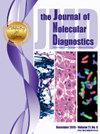Fragile X Syndrome Carrier Screening Using a Nanopore Sequencing Assay
IF 3.4
3区 医学
Q1 PATHOLOGY
引用次数: 0
Abstract
Fragile X syndrome (FXS) is the leading cause of monogenic autism spectrum disorder and inherited intellectual disabilities. Although the value of population-based FXS carrier screening has been acknowledged, appropriate screening methods are urgently required to establish and implement screening programs. We developed a nanopore sequencing–based assay that includes data analysis software to identify FXS carriers. Reference and clinical samples were used to evaluate the performance of the nanopore sequencing assay. Triplet-primed PCR and PacBio sequencing assays were used for comparisons. Nanopore sequencing identified reference carrier samples with a full range of premutation alleles in single-, 10-, and 100-plex assays, and identified AGG interruptions in an allele-specific manner. Moreover, nanopore sequencing revealed no size preference for amplicons containing different-length CGG repeat regions. Finally, nanopore sequencing successfully identified three carriers among 10 clinical samples for preliminary clinical validation. The observed variation in CGG repeat region size resulted from the base calling process of nanopore sequencing. In conclusion, the nanopore sequencing assay is rapid, high-capacity, inexpensive, and easy to perform, thus providing a promising tool and paving the way for population-based FXS carrier screening.
使用纳米孔测序法筛选脆性X综合征携带者。
脆性X染色体综合征(FXS)是单基因自闭症谱系障碍和遗传性智力残疾的主要原因。虽然基于人群的FXS携带者筛查的价值已得到认可,但迫切需要适当的筛查方法来建立和实施筛查计划。我们开发了一种基于纳米孔测序的检测方法,其中包括数据分析软件来识别FXS携带者。采用参考样本和临床样本评估纳米孔测序法的性能。采用三重引物PCR和PacBio测序法进行比较。纳米孔测序在单、10和100 plex分析中鉴定了具有全范围预突变等位基因的参考载体样本,并以等位基因特异性的方式鉴定了AGG中断。此外,纳米孔测序显示,含有不同长度CGG重复区域的扩增子没有尺寸偏好。最后,纳米孔测序成功地从10个临床样本中鉴定出3个携带者,进行初步临床验证。观察到的CGG重复区大小的变化是由纳米孔测序的碱基调用过程引起的。总之,纳米孔测序分析具有快速、高容量、廉价和易于执行的特点,因此为基于人群的FXS载体筛选提供了一种有前途的工具。
本文章由计算机程序翻译,如有差异,请以英文原文为准。
求助全文
约1分钟内获得全文
求助全文
来源期刊
CiteScore
8.10
自引率
2.40%
发文量
143
审稿时长
43 days
期刊介绍:
The Journal of Molecular Diagnostics, the official publication of the Association for Molecular Pathology (AMP), co-owned by the American Society for Investigative Pathology (ASIP), seeks to publish high quality original papers on scientific advances in the translation and validation of molecular discoveries in medicine into the clinical diagnostic setting, and the description and application of technological advances in the field of molecular diagnostic medicine. The editors welcome for review articles that contain: novel discoveries or clinicopathologic correlations including studies in oncology, infectious diseases, inherited diseases, predisposition to disease, clinical informatics, or the description of polymorphisms linked to disease states or normal variations; the application of diagnostic methodologies in clinical trials; or the development of new or improved molecular methods which may be applied to diagnosis or monitoring of disease or disease predisposition.

 求助内容:
求助内容: 应助结果提醒方式:
应助结果提醒方式:


